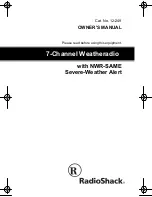
RF400 Series Spread Spectrum Data Radio/Modems
28
6. Troubleshooting
If you can’t connect, check out these possible causes:
1.
Datalogger or Wiring Panel lacks 12 V power on pin 8 of CS I/O port
The RF400 should go through its initialization with red and green LEDs
lighting (see Section 4.1.1) when serial cable is connected if 12 V is
present on CS I/O connector (see Quick Start Table 1). If needed obtain
the optional Field Power Cable (CSI Item # 14291) to connect between
datalogger 12 V output terminals and RF400 “DC Pwr” jack to supply
power to the RF400.
2.
Active Interface set wrong
This setting should normally be “Auto Sense” unless you have a phone to
RF400 base station with PS512M and COM210 which requires the
“COM2xx to RF400” setting or you have a PakBus datalogger requiring
“Datalogger CSDC” due to another M.E. peripheral present. You could
set the Active Interface to RS-232 or Datalogger Modem Enable if that is
its permanent assignment, otherwise “Auto Sense” may be better.
3.
Low or weak battery voltage or 12 VDC supply voltage
The power supply battery may not be charging properly due to solar panel
orientation, poor connection, or due to a charging transformer problem.
The battery itself may have discharged too low too many times, ruining
the battery. Lead acid batteries like to be topped off.
Power supply must be able to sustain at least 9.6 V (datalogger minimum)
even during 75 mA transmitter bursts lasting only a few milliseconds.
4.
Lightning damage to RF400
Swap in a known good RF400 with the same settings and see if this cures
the problem. Lightning damage can occur leaving no visible indications.
A “near miss” can cause damage as well as a more direct hit with
evidence of smoke (see Appendix K for pass/fail tests).
5.
Lightning damage to antenna and/or cable
Swap in a known good antenna and/or cable. Hidden damage may exist.
6.
Moisture in coaxial antenna cable
It is possible that moisture has penetrated inside the plastic sheath of the
coaxial cable. Water inside the cable can absorb RF energy and attenuate
the transmitted signal; the received signal would also be attenuated. It is
difficult to dry out the interior of a coaxial cable. Substitution of a dry
cable is recommended.
Placing a wet cable in a conventional oven at 160
°
F for a couple of hours
should dry it out. Shield the antenna cable against damage from radiated
heat from the oven element by placing the coiled cable on a large cookie
sheet or a sheet of aluminum foil. See section 5.3.2 (3.d) for information
on weatherproofing the antenna cable.
Summary of Contents for RF400
Page 4: ...This is a blank page...
Page 8: ...RF400 Table of Contents iv This is a blank page...
Page 40: ...This is a blank page...
Page 44: ...Appendix B Setup Menu B 4 This is a blank page...
Page 54: ...This is a blank page...
Page 64: ...Appendix H Distance vs Antenna Gain Terrain and Other Factors H 8 This is a blank page...
Page 72: ...Appendix J Monitor CSAT3 via RF400 Series J 2 This is a blank page...
Page 88: ...Appendix L RF400 RF410 Average Current Drain Calculations L 10 This is a blank page...
Page 89: ...This is a blank page...
















































